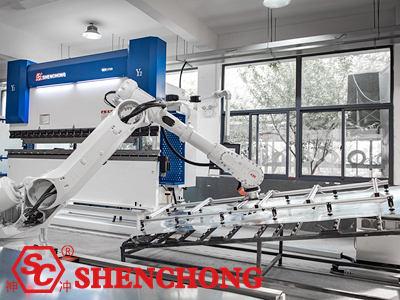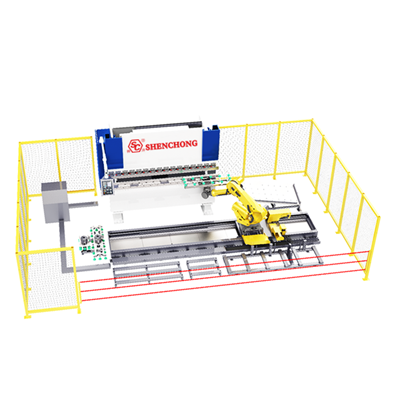
Flexible bending automation technology refers to the use of robots, CNC bending machines, automated loading and unloading devices, visual recognition, and intelligent control systems in sheet metal bending production to achieve high-efficiency, high-variety, small-batch, and even single-piece flexible bending production. It is a typical application of intelligent manufacturing and flexible production in sheet metal processing.

Simply put, flexible bending automation technology incorporates robotics, automated loading and unloading, follow-up support, visual recognition, and intelligent control systems into the sheet metal bending process, enabling press brakes to accommodate high-variety, small-batch, and even single-piece customized production.
The core of this technology lies in "flexibility" and "automation":
Flexible bending automation technology combines a CNC press brake with an industrial robot (or automated loading and unloading system), utilizing intelligent programming, visual positioning, and auxiliary follow-up devices to achieve an integrated production method for automatically grasping, flipping, positioning, and bending sheet metal work pieces.
This technology can flexibly adjust the production cycle and bending path based on different work piece shapes and process requirements, thereby meeting diverse production needs.
Adapts to the production of a wide variety of work pieces and specifications
Quickly changes bending tooling and programs
Supports small batches and customized orders
Robots automatically load and unload, grasp, and flip parts
Automatic positioning and angle compensation
Connects to automated sheet metal storage and laser cutting systems
Software automatically generates bending programs
Vision system identifies work piece position
Interfaces with MES/ERP systems for intelligent production scheduling

The technical core of flexible bending automation can be summarized as "flexibility + intelligence + automation + high precision."
Adaptability to a variety of products and small batches: Rapidly respond to production demands for diverse work pieces, eliminating reliance on the experience of skilled workers.
Quick Changeover: Utilizing CNC systems and modular tooling, rapid switching of bending programs and molds is achieved.
Strong Process Versatility: Adapts to sheet metal parts of varying specifications, thicknesses, and shapes.
Intelligent Programming: Utilizes CAM software or AI algorithms to automatically generate bending paths and robot motion programs.
Virtual Simulation: Validates bending processes through digital twins, reducing on-site commissioning time.
Adaptive Compensation: The system automatically corrects for angle and position deviations based on real-time monitoring.
Automatic loading, unloading, and flipping by robots: Replacing complex, repetitive, and even dangerous manual operations.
Follow-up lifting device: ensures that large or heavy plates do not sag or deform during bending. Multi-axis collaboration: The press brake and robot are highly synchronized to ensure precise bending.
CNC press brake: Equipped with multi-axis control (such as 4+1 or 6+1 axes), it offers high bending accuracy and flexibility.
Angle compensation and detection system: Real-time angle monitoring automatically compensates for slide and work piece deformation.
Energy-saving drive: Hybrid or servo pump control ensures a balance between efficiency and energy consumption.
MES/ERP integration: Enables automated production scheduling, process data traceability, and production progress monitoring.
Smart warehousing integration: Connects to automated warehouses, laser cutting, and welding lines to create a flexible production line.
Data-driven optimization: Leveraging big data and AI, the system continuously optimizes bending processes and scheduling efficiency.
Can quickly adapt to sheet metal bending tasks requiring multiple varieties, small batches, or even single-piece customizations.
Quick program and tooling switching allows for rapid adaptation to the diversification of orders.
Industrial robots or automated devices perform loading and unloading, handling, flipping, and positioning.
Reducing manual intervention ensures continuous and stable production.
Automated programming and process optimization are achieved through technologies such as offline programming, visual recognition, and digital twins.
The system detects bending angles in real time and automatically compensates for them.
CNC press brakes are equipped with angle compensation and multi-axis control, resulting in high bending precision.
This ensures consistent batch production and avoids human error.
Can be integrated with laser cutting, automated warehousing, and welding production lines to form a flexible manufacturing system.
The modular structure facilitates expansion and upgrades.
Automated continuous bending with stable cycle times significantly shortens production cycles.
Addresses the challenges of high manual labor intensity and a shortage of skilled workers.
Long-term operation significantly reduces labor costs.
Intelligent compensation and visual inspection improve bending accuracy and stability.
Reduced defective rates and increased yield rates.
Eliminates dangerous processes such as workers handling large and thick plates, improving the working environment.
Can be integrated with MES/ERP for intelligent scheduling and process data traceability.
Meets the development needs of future smart factories and flexible manufacturing.
The core technology of flexible bending automation is to achieve a highly efficient, unmanned, and flexible sheet metal bending solution suitable for high-mix, low-batch production by integrating high-precision CNC press brakes with robots/servo systems, intelligent programming and compensation, and information systems.
The key features of flexible bending automation technology are:
- Flexibility (quick changeover, high-mix, low-batch production)
- Intelligence (offline programming, visual recognition, angle compensation)
- Automation (robot loading and unloading, servo support)
- High precision (CNC press brakes + intelligent compensation)
- Information integration (MES/ERP system integration)
Comparative Dimensions | Traditional manual bending | Flexible bending automation |
Production Efficiency | Efficiency depends on worker skill, resulting in unstable cycle times and low batch production efficiency | Automated continuous bending, stable cycle time, and high efficiency |
Product Precision | Easily affected by operator skill, resulting in poor bending angle consistency | CNC system + angle compensation, high precision and good consistency |
Labor Dependence | Requires a large number of skilled workers, resulting in high labor intensity | Automated robots and follow-up devices replace manual labor, significantly reducing dependency |
Safety | Handling large or thick plates presents safety risks | Automated loading and unloading and follow-up lifting, high operational safety |
Cost Structure | Low initial investment, but high long-term labor costs | High initial investment, but stable operation and low long-term labor costs |
Quality Stability | Highly affected by human factors, resulting in significant batch variations | Automated control, strong product quality stability |
Informatization/Intelligence | Virtually incompatible with MES/ERP systems | Can be integrated with smart warehousing, MES/ERP, and support smart manufacturing |
- Traditional manual bending: Suitable for single-product, high-volume, low-cost, and low-precision production scenarios.
- Flexible bending automation: More suitable for modern sheet metal processing scenarios requiring high variety, small batches, customization, and high precision, in line with the trend of intelligent manufacturing.
Project | Traditional Manual Bending | Flexible Bending Automation | Differences/Advantages |
Initial Investment | Low cost (1 CNC press brake ≈ $20,000–$50,000) | High (Press Bender + Robotic Cell ≈ $70,000–$150,000) | Automation investment is approximately 3–4 times higher |
Labor Allocation | Two people per machine (loading and unloading + operation) | One-person inspection required (Automatic loading and unloading + Robotic Bending) | Reduces labor by 1–2 people per unit |
Labor Cost | 2 people x $50,000/year ≈ $100,000/year | One-person inspection ≈ $50,000/year | Annual savings of approximately $50,000 per unit |
Production Efficiency | Approximately 200 pieces/shift (depending on operator proficiency) | Approximately 350–450 pieces/shift (Stable cycle time, 24/7 continuous operation) | Efficiency increases by 70%–120% |
Product Yield | Quality rate approximately 80% (significantly affected by manual labor) | Quality rate approximately 90% (Automated compensation and inspection) | Yield increases by 10% |
Maintenance Cost | Relatively low, but high labor costs | Average annual maintenance approximately $20,000 | Equipment maintenance costs are slightly higher |
Overall Cost Recovery Cycle | Unable to reduce long-term labor dependence | Return on investment approximately 2–3 years (depending on labor costs and production volume) | High-efficiency period begins after 3 years |
Applicable Orders | Small batches, high variety, and frequent workpiece changes | Single product, high volume, high precision | Automation advantages become more pronounced |
Flexible bending technology is characterized by flexibility, intelligence, automation, and high precision. Its advantages are reflected in improved efficiency, stable quality, reduced labor, flexible production, and high safety. It is one of the core technologies for the sheet metal manufacturing industry to develop towards intelligence and flexibility.